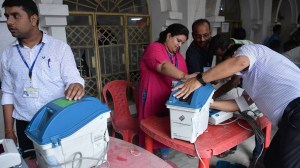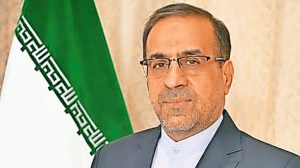- India
- International
State of Surveillance: Who controls the data collected from CCTVs in the capital?
The proposal to install CCTV cameras across the capital has become the latest flashpoint between the AAP government, which links the project to safety, and the Lt- Governor, who has flagged privacy concerns and made a pitch for standard operating procedures. At the centre of debate is a key question: Who controls the data collected from these CCTVs?
 The capital has at least 2.5 lakh CCTV cameras monitoring people in public spaces. (Express photo by Praveen Khanna)
The capital has at least 2.5 lakh CCTV cameras monitoring people in public spaces. (Express photo by Praveen Khanna)
In the opening lines of 1984, George Orwell’s prescient depiction of a dystopian society, the protagonist Winston Smith is desperately trying to escape the gaze of ‘Big Brother’, the all-seeing, all-knowing State. As a political storm brews between the Arvind Kejriwal government and Lieutenant Governor Anil Baijal over installation of CCTV cameras in the capital, the question now appears to be: Who is watching ‘Big Brother’?
According to data collated from multiple authorities, the capital has at least 2.5 lakh CCTV cameras monitoring people in public spaces. Once the Delhi government’s project to install more cameras in public places and schools materialise, the number will cross 5 lakh. What happens to the countless hours of footage collected each day, and who controls this data, is at the heart of the tussle playing out in the capital.
READ | CCTV camera issue: CM Arvind Kejriwal, colleagues sit on ‘dharna’ near L-G office
While there are CCTV networks under various public and private authorities such as the Delhi Police, Delhi Metro, municipal corporations and commercial establishments, stakeholders told The Indian Express that there are no clear-cut protocols or standard operating procedures (SOPs) to control, access and handle the data — or prevent a potential privacy breach.
Bone of contention
On May 8, a day after Delhi Congress chief Ajay Maken alleged irregularities in the AAP government’s tendering process relating to the supply and commissioning of cameras, Baijal constituted a panel to draft an SOP concerning CCTVs. “Uncontrolled and unregulated mushrooming of CCTVs does not lead to any effective outcome for security and law enforcement, and it may encroach upon the privacy of individuals,” he said in a statement issued later.

While the move invoked a sharp reaction from the AAP, which accused the L-G of “politicising” safety of citizens, proceedings of an ongoing case on women’s safety in the Delhi High Court — following the December 2012 gangrape — has revealed that the Delhi government and the Delhi Police have, in fact, been sparring for years “with regard to the control and use of the live feed” of CCTVs in Delhi.
READ | Govt panel wants norms fixed for installing CCTVs at schools
The AAP maintains that in scaling up installation of CCTVs across the capital, it would replicate the “New Delhi Municipal Council (NDMC) model” — in other words, the SOP being followed in Kejriwal’s New Delhi constituency. “The real bone of contention is the SOP being prepared by the L-G’s panel.

Every camera would have to clear the SOP before installation. Even the ones currently installed would have to come under it. It is basically a ploy to derail the project. Why create another when you have one in NDMC?” Kejriwal’s advisor Gopal Mohan said.
However, a top NDMC office-bearer who did not wish to be named said no comprehensive SOP exists in NDMC either: “Saying we have a model would not be appropriate. At certain commercial establishments like the Palika Kendra, we have installed CCTVs and the feed is monitored by the market association. In certain colonies, RWAs control the feed after cameras are put up using MLALAD funds. These are all standalone systems. We are trying to create a command and control centre.”
Around 2,100 CCTVs have been installed under the NDMC in the last four years. The Delhi Police has, meanwhile, installed 4,067 CCTVs in police stations, court premises and markets till date, and around 2.3 lakh cameras across the city under the community policing initiative ‘Nigehbaan’. However, except for ones directly installed by them, the feed of the vast network of cameras is not in the police’s hands, and to access the data collected by private networks, police first have to place a request. Moreover, no guidelines exist to preserve the footage or prevent its misuse.
That said, CCTVs continue to be an invaluable tool in cracking cases, said police. “CCTV cameras have proved to be an effective instrument in prevention and detection of crime and improving security in the capital,” Special Commissioner of Police Dependra Pathak told The Indian Express. Just last week, the High Court pulled up the Delhi Police after a homeless woman was killed in a park near Shanti Van. “Had you done this (installing CCTV cameras at prime locations) in time, your work would have been lessened,” it said.
Safety versus privacy
Despite their need in law enforcement, the question of privacy remains, said stakeholders. “The government plans to install another 1.4 lakh cameras and that is actually the easiest part. The question is, who is going to handle the data and for what purpose? Who will access that data? For how long will the data be retained? Multiple networks need to be integrated. What we need is a body to regulate, strict SOPs and standardisation of technology,” said a source in the security establishment. In fact, the debate on privacy implications of surveillance rages on even in cities such as London, despite having a unique authority called the ‘Surveillance Camera Commissioner’ which seeks to encourage compliance with a ‘surveillance camera code of practice’.
Among major Indian cities, the Mumbai Police operates a network of around 5,000 CCTVs, and control rooms at its headquarters monitor the cameras. In Kolkata, the government has no immediate plans to install CCTVs in the city, but is currently in the process of putting up 244 cameras in the administrative headquarters, Nabanna, taking the total to 400.
According to Agnidipto Tarafder, assistant professor of law in the West Bengal National University of Juridical Sciences, India continues to operate without a data protection law, which can attempt to introduce a single authority or data controller to oversee the entire process of its collection, analysis and dissemination.
“The Justice B N Srikrishna committee, which is working on it, has released a white paper seeking comments. We have to wait for the legislation to be able to adjudge possibilities of use or abuse. That said, a number of countries abroad have already made use of CCTV monitoring systems and have clear guidelines which can serve as a model for India… The foremost is the European Union General Data Protection Regulation, which enlists clear guidelines as to how data can be captured, used, for how long it can be retained, etc. In the US, the Department of Homeland Security has its own set of guidelines,” said Tarafder.
In fact, while ordering the expeditious installation of CCTVs in crime-prone areas in March 2015, the High Court had added a rider: “We also make it clear that when the CCTVs are installed, special regard shall be held to maintaining the privacy of individuals and that CCTVs shall only be installed in public areas without encroaching on any private rights of individuals.”
The ever-expanding nature of the city, however, makes this difficult. The CCTV feed of the Delhi Metro, which carries around 25 lakh commuters daily, can be accessed by DMRC for operational purposes and CISF for security purposes. The footage is preserved for seven days. DMRC says it has an SOP, but refused to share details. In global transport systems, including Transport for London, SOPs and protocols to protect privacy are shared publicly.
At the Delhi Airport, where cameras come under the guidelines of the Bureau of Civil Aviation Security, the CCTV system has facilities of analytics and can also have facial recognition and number plate reading. According to Tarafder, with attempts being made to link all possible citizen information through the Aadhaar number, the possibility of tracking through such advanced CCTVs go far beyond the usual. “In other words, with influx of newer technologies, it will soon be possible that a picture taken of your face shall reveal all details about you — from PAN, mobile number, biometrics, etc, since these are linked to your Aadhaar number,” he said.
The government has also appointed a consultant in connection with the Cabinet decision to install 6,350 cameras in DTC and cluster buses, the feed of which is likely to be monitored from a control room in the transport department’s headquarters in north Delhi.
Conscience keeper?
The fact that CCTVs are not limited to public spaces, but are also making their way into living rooms, means good business. According to Yogesh B Dutta, chief operating officer of CCTV manufacturer CP Plus, the industry is witnessing an annual growth rate of 25-30%.
“The industry is still largely B2B (business to business), but the B2C (business to consumer) segment is catching up. It is still minuscule, though. In a country where the police to people ratio is abysmally low, CCTVs can play a great role. The moment you know you are on camera, your behaviour changes. It can be the conscience keeper of society,” Dutta said.
CP Plus had, through L&T, bid for the Rs 571-crore Delhi PWD contract to install 1.4 lakh more CCTVs across the capital. The project eventually went to PSU Bharat Electronics Ltd and its vendor Prama HikVision. The BEL vendor is an India-China partnership firm.
Even as a tussle plays out over this PWD contract, another Rs 597-crore project to install 1.47 lakh CCTVs in around 1,028 Delhi government-run schools, including in classrooms, is about to gain momentum, as the PWD has been directed to carry out installation during summer vacations.
As per the plan, parents will be able to track their children in classrooms in real-time through a mobile app while the principal of each school will monitor their activities through an LED screen. The move has sparked a debate but a bulk of private schools in the city have quietly put their children under CCTV surveillance over recent years.
Priyanka Mehta, principal of Amity International School, Mayur Vihar, said the school has CCTV in classrooms and the visitors room, but not in private places such as the staff room or near washrooms. Asked how privacy of children is ensured, Mehta said, “CCTVs are put at places which are in public domain… the classroom is a public place where no private activity can be done. What privacy issues can come out of classrooms?”
She said the school has a well-defined policy on who controls the footage. “There are strong firewalls and nobody can go see the footage. We do not even allow parents to see it. If they demand, we see it ourselves and let them know. In the control room, the person in-charge cannot go with a transfer gadget; phones are not allowed inside either.”
“The footage is preserved for three months. But sometimes if there is an incident, we keep the clipping and use it as evidence. CCTVs have been there for quite some time now but more so after many untoward incidents in schools,” she said. CCTVs already exist in a few government schools as well. At Sarvodaya Co-ed Senior Secondary School in Rohini’s Sector 8, principal A K Jha said there is a CCTV at the playground and the main gate, while cameras will soon be put up in classrooms.
“It keeps miscreants away as they get scared. It is also important to keep track of younger children who come to our schools, and to intervene in any scuffles among older boys. Only the principal can see the footage, which is kept for 15 days,” he said.
Delhi High Court proceedings on a writ petition on CCTVs:
Sept, 2015: Police accept proposal that Delhi government would procure CCTVs and put them up at locations indicated by the Delhi Police. Delhi government states it is only the equipment they shall be providing as a one-time affair, and maintenance and surveillance would be the responsibility of the police.
Oct, 2015: Court observes that authorities should take care that live feeds are not misused in any manner or tampered with. Says authorities should sort out the issue of authenticity and chain of command over the data recorded through CCTVs.
Jan, 2017: Court says matter got sidelined, seeks fresh updates from govt and police.
Oct, 2017: No progress, court seeks affidavits from both parties.
Nov, 2017: Delhi govt informs court tenders floated for 1.4 lakh CCTVs.
Mar, 2018: Court orders Delhi Chief Secy to resolve dispute of govt with police with respect to placement of CCTVs in vulnerable areas.
Apr 18: Latest News
- 01
- 02
- 03
- 04
- 05






































